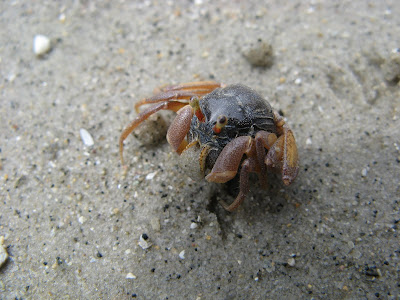As a Johorean, i don't even know where is Sungai Pulai until one day that, someone from Team Seagrass Singapore forwarded one email regarding to Sungai Pulai.
So i did a small search on this.
I myself won't dream of to see seahorse in Pengerang, but to my pleasant surprise, near by (kind of) around Pontian, there are seahorses!
I almost couldn't think of any places in Johor where there is a wide public known of rich marine lives.
(If you are thinking about Tioman, then, come on! Tioman belong to the state of Pahang! :P)
Please let other know about this place so that there will be at least someone to speak for the place.
All of us can play a role.

Photo from SOS gallery.
What is Seahorse?
Seahorses are a genus (Hippocampus) of fish.
Seahorses and pipefishes are notable for being the only species in which males become "pregnant".
The female inserts her ovipositor into the male’s brood pouch, where she deposits her eggs, which the male fertilizes. The fertilized eggs then embed in the pouch wall and become enveloped with tissues.
Most seahorse species' pregnancies lasts approximately two to three weeks
About Sungai Pulai Wetland
http://www.wetlands.org/malaysia/en/articlemenu.aspx?id=5bc18f0e-b793-4967-9fb2-e9236b055b23
About Save Our Seahorse
http://www.sosmalaysia.org/home.html
The nightmare for the seahorse and Sungai Pulai has finally show up.
A proposed development plan which involve the clearing of 2255 acres (913ha) of mangroves at Sungai Pulai (near the Ramsar Site) for petrochemical and maritime industries has its EIA open for public reviewing.
The types of industries proposed are shocking. They include the manufacturing of industrial gases, synthetic resins, paints, varnishes, petro refinery, shipbulding and repair, chemical incinerator and harzadous
waste, fertilizers and pesticides, rubber remilling and latex processing
etc.
This is the intended rape of Sungai Pulai.
The EIA is open for public reviewing and comments starting 19 July 2007.
Please send in your comments by the end of the month. The EIA executive summary is attached here. Also attached is my general comments. Alternatively you can also download the EIA report from the DOE website.
Your comments can make a difference. Pls spread the words as far as you can to the like-minded people.
Please prevent the rape of Sungai Pulai.
Sincerely Yours,
Choo Chee Kuang
Save Our Seahorses
Below are the some people whom you might want to send in your comments
(email, fax, post letter, cc whatever - the more the better)
............................................................................
Director,
Department of Environment
Ministry of Natural Resources
Level 1-4, Podium 2 & 3,
Wisma Sumber Asli,
No 25, Persiaran Perdana
Precint 4, Federal Government Administrative Centre
62573, Putrajaya
Tel: 03-88712000 or (2200)
Fax: 03-88891973
Fax (Director General Office) : 03-88891036
Pengarah
Jabatan Alam Sekitar Johor Bahru
Tingkat 1&2, Bangunan Hasil,
Jalan Padi Emas 1, Bandar Baru Uda,
81200, Johor Bahru
Tel: 07-2356042
Faks: 07-2356071
Email: johor@doe.gov.my
Prime Minister
Prime Minister's Office
Federal Government Administration Center
Bangunan Perdana Putra
62502 Putrajaya
Malaysia
Tel: 603-88888000
Fax: 603-88883444
Email: ppm@pmo.gov.my
Dato' Haji Abdul Ghani Othman
Menteri Besar Negeri Johor
Pejabat Menteri Besar Negeri Johor
Aras 1, Bangunan Sultan Ibrahim, 80502 Johor Bahru, Johor.
No. Telefon : 07-2244148 / 07-2234789
No. Faksimili : 07-2230867
Seaport Worldwide Sdn Bhd (Project Proponent)
Attn: Miss Susan Chiang
Level 5, Wisma Kontena, PO Box 151,
81707
Pasir Gudang
Tel: 607-2535888
Fax: 607-2522507
Email: susan@johorport.com.my
Hijau Sekitar Sdn Bhd (EIA consultants)
Ir. Dr. Wee Ka Siong
124A, Jalan Lembah,
Taman Tasek, 80200
Johor Bahru
07-2453388 /235 3322
Fax: 07-2355666
Y.B. Dato' Haji Abd. Latiff Bin Yusof D.P.M.J., P.I.S
SUKJ( Cawangan Jurutulis / Majlis Mesyuarat Kerajaan )
Aras 1, Bangunan Sultan Ibrahim, 80503 Johor Bahru, Johor.
No. Telefon : 07-2239780 / 07-2769780 / 07-2241957
No. Faksimili : 07-2246359
Unit Sains Teknologi dan ICT Negeri Johor
Aras 2, Bangunan Sultan Ibrahim, Jalan Bukit Timbalan, 80000 Johor Bahru,
Johor.
No. Telefon : 07-2238239 / 07-2215030
No. Faksimili : 07-2234269
UPEN (Unit Perancang Ekonomi Negeri)
Aras 2, Bangunan Sultan Ibrahim, Jalan Bukit Timbalan, 80000 Johor Bahru,
Johor.
No. Telefon : 07-2241768 / 07-2241698
No. Faksimili : 07-2241323
Tuan Haji Abd.Rahman bin Mohamed Dewam
Jurutulis Dewan Negeri Johor /
Majlis Mesyuarat Kerajaan Negeri Johor.
07 - 2239780 / 2244203 ext. 108
Email : - arahmanmd@johor.gov.my
Y.B. Encik Freddie Long Hoo Hin
JAWATANKUASA PELANCONGAN DAN ALAM SEKITAR
Aras 1, Bangunan Sultan Ibrahim, 80503 Johor Bahru, Johor.
No. Telefon : 07-2239780 / 07-2769780 / 07-2241957
No. Faksimili : 07-2246359
Y.B. Datuk Halimah binti Mohamed Sadique
JAWATANKUASA KERAJAAN TEMPATAN DAN KESIHATAN
Aras 1, Bangunan Sultan Ibrahim, 80503 Johor Bahru, Johor.
No. Telefon : 07-2239780 / 07-2769780 / 07-2241957
No. Faksimili : 07-2246359

Photo from Chay Hoon, but this is from Chek Jawa Singapore. :)
Choo's Comments on EIA Executive Summary






The EIA Executive Summary has 20 pages. If you are interested to read, please email me and i will send it to you.


































